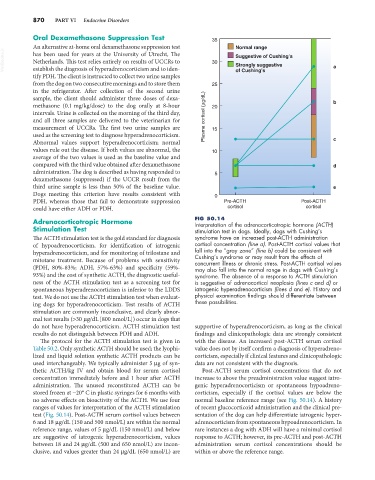Page 898 - Small Animal Internal Medicine, 6th Edition
P. 898
870 PART VI Endocrine Disorders
Oral Dexamethasone Suppression Test 35
An alternative at-home oral dexamethasone suppression test Normal range
VetBooks.ir has been used for years at the University of Utrecht, The 30 Suggestive of Cushing’s a
Netherlands. This test relies entirely on results of UCCRs to
Strongly suggestive
establish the diagnosis of hyperadrenocorticism and to iden-
tify PDH. The client is instructed to collect two urine samples of Cushing’s
from the dog on two consecutive mornings and to store them 25
in the refrigerator. After collection of the second urine
sample, the client should administer three doses of dexa-
methasone (0.1 mg/kg/dose) to the dog orally at 8-hour 20 b
intervals. Urine is collected on the morning of the third day,
and all three samples are delivered to the veterinarian for Plasma cortisol (µg/dL)
measurement of UCCRs. The first two urine samples are 15
used as the screening test to diagnose hyperadrenocorticism.
Abnormal values support hyperadrenocorticism; normal c
values rule out the disease. If both values are abnormal, the 10
average of the two values is used as the baseline value and
compared with the third value obtained after dexamethasone d
administration. The dog is described as having responded to 5
dexamethasone (suppressed) if the UCCR result from the
third urine sample is less than 50% of the baseline value. e
Dogs meeting this criterion have results consistent with 0
PDH, whereas those that fail to demonstrate suppression Pre-ACTH Post-ACTH
could have either ADH or PDH. cortisol cortisol
Adrenocorticotropic Hormone FIG 50.14
Interpretation of the adrenocorticotropic hormone (ACTH)
Stimulation Test stimulation test in dogs. Ideally, dogs with Cushing’s
The ACTH stimulation test is the gold standard for diagnosis syndrome have an increased post-ACTH administration
of hypoadrenocorticism, for identification of iatrogenic cortisol concentration (line a). Post-ACTH cortisol values that
hyperadrenocorticism, and for monitoring of trilostane and fall into the “gray zone” (line b) could be consistent with
mitotane treatment. Because of problems with sensitivity Cushing’s syndrome or may result from the effects of
concurrent illness or chronic stress. Post-ACTH cortisol values
(PDH, 80%-83%; ADH, 57%-63%) and specificity (59%- may also fall into the normal range in dogs with Cushing’s
93%) and the cost of synthetic ACTH, the diagnostic useful- syndrome. The absence of a response to ACTH stimulation
ness of the ACTH stimulation test as a screening test for is suggestive of adrenocortical neoplasia (lines c and d) or
spontaneous hyperadrenocorticism is inferior to the LDDS iatrogenic hyperadrenocorticism (lines d and e). History and
test. We do not use the ACTH stimulation test when evaluat- physical examination findings should differentiate between
ing dogs for hyperadrenocorticism. Test results of ACTH these possibilities.
stimulation are commonly inconclusive, and clearly abnor-
mal test results (>30 µg/dL [800 nmol/L]) occur in dogs that
do not have hyperadrenocorticism. ACTH stimulation test supportive of hyperadrenocorticism, as long as the clinical
results do not distinguish between PDH and ADH. findings and clinicopathologic data are strongly consistent
The protocol for the ACTH stimulation test is given in with the disease. An increased post-ACTH serum cortisol
Table 50.2. Only synthetic ACTH should be used; the lyophi- value does not by itself confirm a diagnosis of hyperadreno-
lized and liquid solution synthetic ACTH products can be corticism, especially if clinical features and clinicopathologic
used interchangeably. We typically administer 5 µg of syn- data are not consistent with the diagnosis.
thetic ACTH/kg IV and obtain blood for serum cortisol Post-ACTH serum cortisol concentrations that do not
concentration immediately before and 1 hour after ACTH increase to above the preadministration value suggest iatro-
administration. The unused reconstituted ACTH can be genic hyperadrenocorticism or spontaneous hypoadreno-
stored frozen at −20° C in plastic syringes for 6 months with corticism, especially if the cortisol values are below the
no adverse effects on bioactivity of the ACTH. We use four normal baseline reference range (see Fig. 50.14). A history
ranges of values for interpretation of the ACTH stimulation of recent glucocorticoid administration and the clinical pre-
test (Fig. 50.14). Post-ACTH serum cortisol values between sentation of the dog can help differentiate iatrogenic hyper-
6 and 18 µg/dL (150 and 500 nmol/L) are within the normal adrenocorticism from spontaneous hypoadrenocorticism. In
reference range, values of 5 µg/dL (150 nmol/L) and below rare instances a dog with ADH will have a minimal cortisol
are suggestive of iatrogenic hyperadrenocorticism, values response to ACTH; however, its pre-ACTH and post-ACTH
between 18 and 24 µg/dL (500 and 650 nmol/L) are incon- administration serum cortisol concentrations should be
clusive, and values greater than 24 µg/dL (650 nmol/L) are within or above the reference range.

